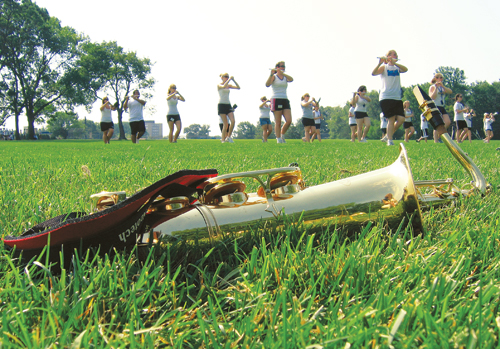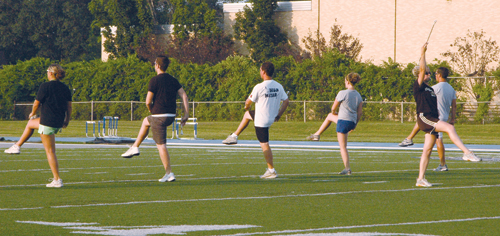
Several years ago, after one of my high school marching bands had earned top honors at a prestigious state marching competition, I was interviewed about the band’s success by a local newspaper reporter. During the course of the interview, the reporter asked me what style of ensemble we patterned ourselves after, perhaps a college band or a drum corps. My reply was “We try not to copy anyone, we create our own style.”
Having attended numerous high school football games, marching band competitions, and parades as both a spectator and adjudicator, it has become increasingly apparent in recent years that many high school marching bands have an identity crisis. Many bands are basically similar in regards to uniform style, marching fundamentals, and drill designs; to a certain degree, they also have similar philosophies used to select the repertoire. The best bands still stand out because of the quality of their musicianship and the precise execution of visual elements in their shows, but even many of these bands often project the same look, lacking a unique identity.
In professional entertainment, such as television, a lack of identity is often a predictor of failure. Sameness in programming breeds boredom and results in a general sense of apathy toward the productions, from both audiences and those who fund it. If there is nothing that stands out about a show or cast, then ultimately the show is replaced by a more unique and entertaining product. It is important to note that the quality of the acting is usually not the reason for cancellation. At a time when many marching bands are seeing their roles diminished at football games due to the use of recorded music, as well as experiencing a decline in the number of participants, a diminished fan base, and budget cuts, perhaps it is time for directors to consider ways to make their marching bands distinctive.
Image, branding, and reputation are key aspects of success in both professional entertainment and the business world, and they are equally important considerations as directors create unique identities for their marching bands. Consider the image the band projects at school, at football games, in competition, and in the community.
Marketing
Communication and promotional materials should consistently project a certain image to the public. Create an official band letterhead by experimenting with fonts, because certain fonts convey distinct images. Once you have selected one, use that lettering style when referencing the band on every communication including letters, handouts, press releases, posters, promotional materials, and websites, as well as on uniforms, parade banners, and equipment vehicles.
Consider developing a band logo. Most schools have an official mascot, so perhaps yours could be altered to convey a band image. If your school mascot is a lion, then the band logo could be a lion playing a trumpet or drum. Enlist the art teacher for help with this or hold a competition for a design with the winner receiving a cash prize or an invitation to guest conduct the band at a school function.
Show Planning
Next, examine the marching band’s image. Review the band’s competition show repertoire for the past four years, considering the style of music and how well the band played certain styles. Also, consider the band members and audience. Students may have enjoyed playing certain styles more than others, and the audience reaction, including those at football games, may have been greater for one style than another. If a trend emerges, then try including certain styles of music on a regular basis. Some bands only play jazz numbers every year, others classical works, and others play rock and other contemporary styles. It is their signature sound in competition, and band members and fans expect it. As a high school band director I developed a musical identity for my bands based on variety. We used classical music as an opener; jazz-rock, big band, or classic rock charts as production numbers; and a pop ballad or spiritual as a closer. There was educational value in the variety of repertoire for the students, and the band demonstrated to adjudicators their musicality and overall technique in the performance of contrasting styles, and – of equal importance – there was something for everyone in the audience. My bands routinely received high music scores as well as enthusiastic responses from audiences at competitions and football games alike.
Concerning repertoire performed at football games, too many directors disregard the notion of entertaining the fans. Many bands only learn their competition show and perform it at every game. This breeds disinterest among football fans and the student body for the marching band. Successful band programs are part of the fabric of a community, and the only way to connect with the public is by performing a variety of music that a diverse group of listeners can appreciate.
Several bands no longer even perform a pregame show. Some simply move onto the field into a block formation, play the National Anthem and occasionally the alma mater or school fight song, and exit. Others play these selections from the stands. Many directors feel that they do not have time to learn and rehearse a pregame show because it would take away from working on the competition show. Directors should examine their priorities and use the pregame show to put school traditions and school spirit on display through music and drill. At some schools long-time fans say that the traditional pregame show is one of the most exciting aspects of game pageantry. Pregame shows can be easy to learn and fun for band members to perform. The goal is to get the audience to participate in school traditions by clapping their hands, cheering, and singing along as the band performs the alma mater and the National Anthem.
Write a pregame show that incorporates basic marching fundamentals and make it the first thing the band learns at preseason rehearsals or band camp. Fundamentals learned in this show will carry over to the competition show. Keep the pregame show simple, but maintain the same music and drill execution standards as in the competition show by rehearsing the music and drill regularly. Pregame music and drill can be used for music and marching warmups at the beginning of rehearsals. Most school alma maters work well as a warm-up chorale. Make the show a school tradition by keeping it similar from year to year. This will aid in the creation of a band identity, and alumni will enjoy hearing music that was performed when they were students.
At many schools, the band rarely performs in the stands during games, and many of those who do perform poorly because they fail to rehearse adequately. Directors often comment that they just don’t have time to learn other music when preparing for competitions. It is no surprise then that recorded music is taking the place of the marching band during games. This is common in professional football stadiums because of the absence of live bands, but this trend unfortunately spread to the college game more than ten years ago and an increasing number of high schools. Rather than allow recorded music to replace the high school marching band as a source of school spirit, work to develop a stands music tradition that becomes an integral part of the high school game.
When selecting music for the stands, consider classic rock tunes and music cheers that will be recognized by parents and students alike, and repeat the tunes from year to year. There are many outstanding published charts available, but do not hesitate to create your own arrangements. Be sure to introduce new tunes on occasion, specifically contemporary pieces that appeal to the student body. Coordinate the band’s efforts with the cheerleaders, as songs and cheers that require audience participation are extremely effective. Select music a grade or two below the contest music so the band can learn the selections quickly. Be sure the music is high energy and scored in reasonable ranges. The students will enjoy the variety and become better musicians by reading more music. Watch the game, cheer, and play whenever appropriate. Also, do not leave the stands and spend the entire second quarter of the game warming up for the halftime show. Bands that have been playing regularly in the stands while demonstrating high musical standards do not need to do this. Remember, if the band is not playing, recorded music will be.
For halftime performances, it is certainly possible to learn and perform more than just the competition show during a season. The philosophy of one show per year may be the single biggest contributor to community and student apathy toward the band program. So many directors have been permitted to embrace a one-show approach by school administrators and band program supporters that it has become the norm at most schools. Rehearsing and performing the same music program for several months is an ill-conceived concept. It certainly makes sense to showcase excerpts of the competition show early in the season to give the band members performance experience, but perform other shows as well. No one enjoys watching the same episode of a television show over and over, so why should directors think that fans will have any interest in watching the same halftime show repeated every week.
Before the football season begins, plan multiple halftime shows. As a high school director, my bands usually performed excerpts of the competition show at the first two football games, a new show for the next game that featured classic rock music with multi-generational appeal, a homecoming show that often was simply background music for the introduction of the queen and her court, and a senior night show featuring contemporary music chosen by the band seniors. For any additional games at the end of the season and all of the away games, I usually programmed the competition show.
The key to learning other shows is to remember that the music and drill do not have to be difficult, just entertaining. If you usually use custom charts for the competition show, use published music scored at a lower grade level for the other shows. Consider shows that consist of only three numbers – an opener, a concert selection featuring the flags, baton twirlers, or cheerleaders, and a closer. Remember, the marching band is in attendance at the game to support the team and entertain the fans. The average fan cannot discriminate between grade levels of music or difficulty of drill. Their opinion of the show, and ultimately their perspective of the band’s musical identity, depends solely on whether the band sounded good at halftime.
Visuals
Also consider the band’s visual image when creating an identity. Begin by evaluating every detail of the band’s basic fundamentals, from the manner in which they hold their instruments to the style of the marching step used. Uniformity and precision are always the goal, but do not hesitate to make
changes in fundamentals for the sake of originality. For example, because most bands today use a glide step, consider a different approach and occasionally incorporate the traditional high step style. It will definitely set the group apart.

Take a close look at the band’s drill designs from the past few years, especially if you hire someone else to write shows. There was a time when nearly all band directors wrote competition show drills for their bands, and variety in drill design was normal. However, as competitions became the focal point for the high school marching bands, originality began to decline. Even some of the top bands, whose precise execution and stunning visuals are exciting to witness, often seem to have similar drill. The designs may be outstanding, but not always unique, as many seem to be copies of the latest trends seen in recent drum corps shows. I have attended competitions with as many as two dozen bands present and suspected that the shows were created by the same four or five drill writers, due to the similarity of the designs. On one occasion, while attending a competition featuring bands from several states, I even saw two bands perform the exact same show – both music and drill. Both band directors believed that they had purchased a custom show.
Consider designing a show, as it is the only way to truly create a unique visual identity. Although some directors may feel that their drill design techniques are inadequate, with practice and dedication anyone who has taken a marching band techniques course in college or marched in a college band or drum corps can do it. View drill design as an opportunity to showcase another aspect of creative artistry. It can be challenging and time consuming, but visual interpretation of music is highly rewarding, and directors who write their shows will know that no other band will perform the same thing.
During the design process, strive to create a signature move and use it in the competition show every year. Early in my career I created what came to be known as a power wedge formation showcasing the brass section. It was so effective that I used it each year in competition as part of the show closer. The music was different each year, but the drill technique was nearly identical. Audiences and adjudicators alike knew what was coming at the end of the show, and soon the power wedge became the visual signature of the band. It was routinely met with standing ovations.
Uniforms
Do not forget band uniforms when creating an identity. In recent years, some bands appear to have intentionally avoided their school colors, mascot, and even school name when selecting and designing uniforms, choosing instead to simply imitate the latest drum corps fashions. Celebrate school colors and mascots to create a unique uniform identity. The uniforms of top college bands have evolved over the years without completely forsaking traditional styles and colors; likewise, high school uniforms represent the band, school, and community and should showcase school pride and spirit to the fullest by developing a contemporary image that still embraces tradition.
Reputation
Many bands can claim a reputation of performance excellence through the number of awards they have won, but it is also important to consider the band’s reputation in the school and community. When recruiting students to the band program, many directors routinely comment concerning the value of having band participation on high school transcripts when applying to college. No one argues with that, but other activities can be helpful as well, so avoid a band program that forces students to choose between band and other activities. My high school bands routinely had students who were athletes, members of clubs and organizations, and leaders in student government. Strive for a band program culture where students understand that excellence in every aspect of school life is expected. Seeing star band members fall short, jeopardizing their future opportunities after high school, is just as heartbreaking as seeing star athletes in similar situations.
Finally, consider the band’s reputation in the community. If the public’s connection to the band program is only through newspaper articles or fundraising events, then the band is really not a valuable component of community life. When scheduling performances, balance football games and band competitions with local events, including parades. It is unnecessary to wait for an invitation to foster goodwill and program support. Seek performances that will showcase musicians to members of the community who may not see the band at games and competitions. For many people, a performance by band members at a local nursing home or retirement community creates a greater sense of pride in the band program than reading a media report of the band’s participation in a band contest held several hours away.
In most areas of modern life diversity and uniqueness are considered good things. For the future health of high school marching bands, perhaps it is time to embrace the same mindset.






